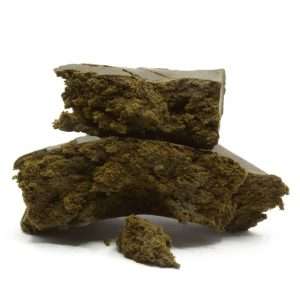Hashish is a cannabis concentrate product composed of compressed or purified preparations of stalked resin glands, called trichomes, from the plant. It is defined by the 1961 UN Single Convention on Narcotic Drugs (Schedule I and IV) as “the separated resin, whether crude or purified, obtained from the cannabis plant”. The resin contains ingredients such as tetrahydrocannabinol (THC) and other cannabinoids—but often in higher concentrations than the unsifted or unprocessed cannabis flower. Purities of confiscated hashish in Europe (2011) range between 3% and 15%. Between 2000 and 2005, the percentage of hashish in cannabis end product seizures was at 18% With the strength of unprocessed cannabis flowers having increased greatly in recent years—with flowers containing upwards of 25% THC by weight—the strength of hashish produced today and in the future is likely to be far more potent than in these older records
The consistency and appearance of hashish is highly dependent on the process used and the amount of leftover plant material (e.g. chlorophyll). It is typically solid, though its consistency ranges from brittle to malleable. It is most commonly light or dark brown in color, though may appear transparent, yellow, black, or red.
Also called:
- Bhang
- Bud
- Dope
- Draw
- Ganja
- Grass
- Hash
- Hashish
- Herb
- Marijuana
- Pollen
- Pot
- Puff
- Resin
- Sensi
- Sinsemilla
- Skunk
- Weed
Quick info
How the drug works varies from person to person
- How you might feel
- ‘Stoned’, happy, giggly and/or sleepy, confused, paranoid.
- Read more about how it feels
- Effects on your body
- Can make some people feel sick and hallucinate.
- Read more about effects on your body
- How long it takes to work
- 1-2 mins on average when smoking. Takes longer to work when eaten – about 45 mins on average.
- Read more about how long it takes to work
- How long the effects last
- 40 mins – 1 hour on average when smoking.
- Read more about how long the effects last
- Common risks
- Cannabis can affect your mental health, especially if you take a lot. Smoking with tobacco increases risk from both drugs. Driving when stoned or high can double your chances of having a serious, or even fatal car crash.
- Read more about the risks
- Mixing drugs
- Mixing drugs is always risky but some mixtures are more dangerous than others.
- Read more about mixing with other drugs
What does it look like?
Soft black resin, furry green leaves and hard brown lumps, cannabis can look very different depending on its type – but it all comes from cannabis plants.
You’re most likely to come across these types:
Weed
Also known as grass, weed is made from drying out the leaves and flowering parts of the cannabis plant. It can look like dried herbs and is usually brownish-green in colour.
Skunk
This is the name given for particular strains of grass that are very strong. Skunk’s become very popular in recent years and is often bright, pale or dark green in colour and covered in tiny crystals.
Hash/hashish
Not nearly as common as it used to be, hash (or hashish) is made from the resin of the cannabis plant and can be black, brown, soft or hard – depending on the type.
Cannabis oil
This is a dark, sticky and honey-coloured substance that’s much less common than other types.
‘Dab’/’shatter’
These are highly concentrated forms of cannabis that are extracted using butane. They come in a solid form known as ‘dab’ or ‘shatter’ and can be used as e-liquids in vape pens.
What does it taste/smell like?
Cannabis has a musky, sweet smell. Some of the more potent types of cannabis can have a stronger smell, but this isn’t a reliable guide to the strength of any particular batch.
Smoke spliffs
In the UK, most people mix it with tobacco and roll it into a cannabis cigarette known as a spliff or joint. Some people don’t use tobacco at all and make weed-only spliffs – either because they prefer it that way or to avoid becoming dependent on nictotine.
Smoke bongs
Users do this mix by mixing the drug with tobacco and putting it in a pipe, lighting it, and then inhaling the smoke through water out of a large tube. There are many types of bongs, and not everyone uses tobacco. Like with joints, using tobacco in bongs increases the risk of nicotine dependence.
Edibles you can eat or drink
People do this by mixing it into cakes (hash brownies), tea, yoghurt or sweets (gummies/lollipops). The amount of cannabis in these products can vary greatly and sometimes – especially in sweets – other harmful drugs (particularly synthetic cannabinoids) are added or used instead. The effects of consuming edibles are unpredictable and it can be very easy to accidentally take a larger dose than you wanted to.
| Quantity | 3grams, 5grams, 10grams, 20grams, 50grams |
|---|
Be the first to review “Chem Dawg Hashish” Cancel reply
Related products
Cannabis Hash
Cannabis Hash
Cannabis Hash
Cannabis Hash
Buy THC Vape pens online
Cannabis Hash
Cannabis Hash
Cannabis Hash












Reviews
There are no reviews yet.